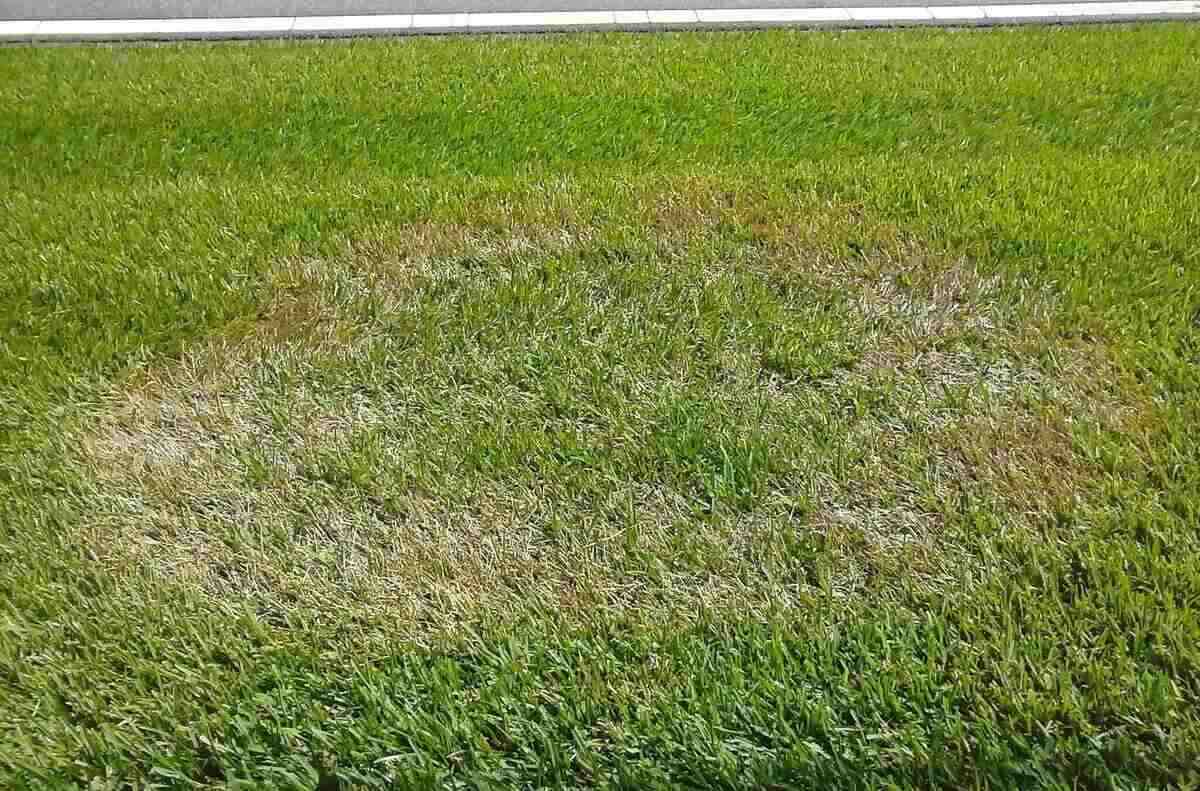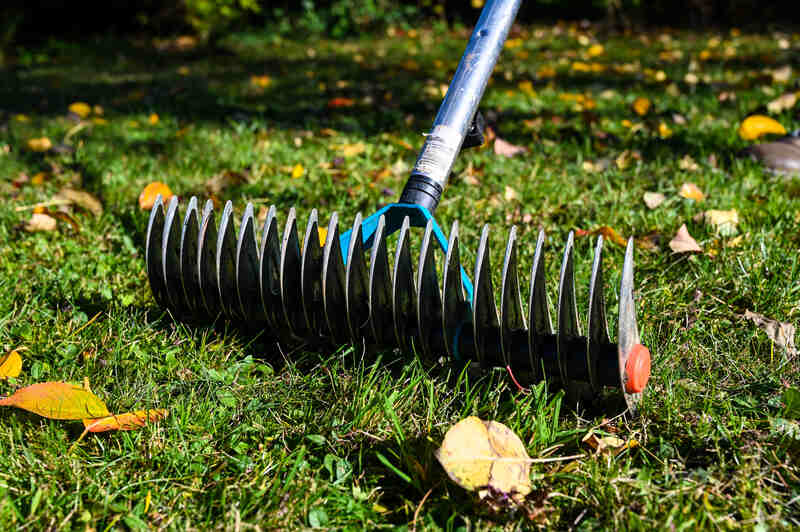
In hot, humid summer conditions, brown patch is a common problem for cool-season lawns. To treat brown patch, reduce moisture, improve air circulation, mow and fertilize correctly, and apply fungicide treatments.
Whether you’re a lawn care beginner or a seasoned expert, brown patch disease can happen to anyone. Here’s how to stop brown patch in its tracks to get your home lawn back to its gloriously green best.
Improve Your Lawn Care
Stop Watering and Reduce Moisture
Brown patch thrives in wet, fertile lawns and hot weather. “I kind of jokingly tell people when you wake up in the morning and go out, and all you hear is the hum of your neighbor’s air conditioning…that’s perfect brown patch weather,” says Dennis Patton. He’s a master gardener for the Kansas State Extension in Johnson County, where brown patch is a common headache.
If you notice signs of brown patch, reduce irrigation and avoid watering in the evenings, which increases the risk of fungal growth and the appearance of common lawn diseases.
Instead, water in the early morning hours: From 5 a.m. to 9 a.m. is the best time to water your lawn as it allows the grass to soak up the water. Then evaporation takes care of any excess moisture before nightfall.
Improve Air Circulation

Remove the dead grass from the affected area to improve air circulation and prevent thatch from forming. Drainage issues also may create a damp environment where brown patch and other fungal diseases thrive.
Correct drainage issues and improve air circulation with these simple tasks:
- Clean the gutters
- Even out low spots
- Dethatch your lawn
Note: See our article 7 Ways to Improve Drainage in Your Yard to help diseased lawns dry out, reducing your fungal problem.
Mow Correctly
If you have an active brown patch problem, avoid mowing until it is resolved (or mow around it). Additionally, an excessively low mowing height can increase disease risk. Try raising your mowing height to 3 or 3.5 inches (if within the proper mowing height for your grass species) to encourage strong roots.
| Are you short on spare time to mow the lawn or perform other lawn care tasks? Contact a LawnStarter lawn care pro to help you out. Our customers spend around $48 for our lawn mowing services. |
Avoid Overfertilizing
Avoid fertilization if you have an active brown patch problem. Since brown patch disease targets cool-season grasses, fertilize in the fall instead of in the spring. It is also recommended to avoid fast-release nitrogen fertilizers altogether, especially if you choose to do a second fertilizer application in the spring.
See Related: When to Fertilize Your Lawn
Aerate Soil

Aerating the soil regularly is an important practice to prevent lawn diseases from developing, including brown patch. Core aeration is a process that uses a machine to remove soil plugs, relieving soil compaction, improving airflow, and promoting a stronger turf that is less susceptible to diseases.
Aerate your lawn every year if you have clay soil or soil that has become compacted due to intensive foot traffic.
See related: Best Time to Aerate and Overseed a Lawn
Adjust Soil pH
An unbalanced soil pH affects your lawn health, and can make your lawn more vulnerable to diseases. Ideally, your soil should be between 5.9 and 7.0. Conduct a soil test and make the adjustments recommended on your soil test report.
Apply lime if your soil is too acidic. For alkaline soils, apply elemental sulfur or other soil amendments to adjust soil pH.
Use Lawn Treatments
Apply Fungicides
Chemical treatment is typically needed in severe brown patch cases or on high-maintenance lawns. Check out our table of fungicides you can use against brown patch:
| Fungicides | Product Examples |
| Azoxystrobin | Heritage GScott’s Disease EX |
| Azoxystrobin (with Propiconazole) | Headway GQuali-Pro Strobe Pro G |
| Pyraclostrobin (with Triticonazole) | Pillar G Intrinsic Fungicide |
| Fluoxastrobin | Fame Granular Fungicide |
Taken from the Clemson Cooperative Extension Home & Garden Information Center
Note: Brown patch fungus can develop resistance to products with only azoxystrobin or fluoxastrobin in their formulas. Prevent this by alternating products or choosing those with at least 2 different lawn fungicides.
In any case, the best way to deal with brown patch is to get ahead of it. “The idea is to prevent the outbreak,” Patton says. Once you already see the damage, you’re working to prevent new outbreaks, so start a preventive schedule of fungicide applications in early spring.
| If you’re unsure about handling fungicides yourself, contact one of our pros to apply a lawn treatment. Our LawnStarter customers spend around $106 per lawn treatment service. |
Treat the Lawn Organically
One of the most effective organic treatment options against brown patch is the bacteria Bacillus amyloliquefaciens strain D747. This bacteria works as an organic fungicide, and OMRI-certified products containing this ingredient are easy to find in organic lawn care stores.
Other organic options include:
- Potassium bicarbonate: Potassium bicarbonate has the same ability as baking soda to fight lawn fungus, but without the sodium that can damage healthy grass. Mix 1 tablespoon of potassium bicarbonate with 1 gallon of water and spray on your turf.
- Neem oil: Neem oil can be purchased in your local home and garden store and can be a helpful ally to prevent brown patch from spreading. Mix 1 ounce of the oil in 1 gallon of water and spray the solution on the affected areas.
- Clove oil: Clove oil contains eugenol, a compound that has antifungal properties and can be used to combat (and prevent) brown patch fungus. Dissolve 2 tablespoons of clove oil in 1 gallon of water and spray on your lawn.
- Garlic: Garlic has known antifungal properties, and either the garlic itself or its oil can be used to control lawn fungus. Mix crushed garlic or garlic oil with water and liquid soap and then spray the mix on the infected area.
Add Beneficial Microorganisms
Strengthen your soil’s ecosystem by adding beneficial bacteria, protozoa, and fungi that compete against and inhibit the growth of harmful lawn diseases. Encourage beneficial microorganisms by adding organic matter to your soil:
- Spread organic mulch
- Topdress your lawn with compost
- Spread grass clippings as mulch
- Add a mycorrhizal inoculant to your soil, which contains beneficial fungi and can be found in your local gardening store.
FAQ
The main signs of brown patch disease are the big brown circles appearing on your lawn, rotten sheathes, and brown lesions on leaf blades.
You may notice them appearing suddenly due to how quickly brown patch develops. “Brown patch can invade rapidly,” Patton says. “You can come home at 5 in the afternoon, walk through a perfectly green front lawn and wake up to brown patch taking hold.”
Even with an effective fungicide, it can take a few weeks for your lawn to recover. Once the hot summer temperatures start to cool down to welcome fall, the turf tends to recover on its own.
Yes, brown patch can lay dormant, waiting for the right conditions to reemerge. So remember to address the underlying causes of the problem, such as excessive moisture, to prevent the fungus from returning.
Wait until you see the affected area (from which you removed the dead grass) start to actively regrow. When overseeding your lawn, avoid high seeding rates. Excessively thick lawns are more susceptible to brown patch disease.
When To Call a Pro
Millions of Americans reach out to professionals to keep their lawn fungus-free, and we have local, experienced, highly-rated professionals in your area. Book a lawn treatment today to see your lawn free from brown patch at last.
Sources:
“Antifungal Activity of Clove (Syzygium aromaticum) Essential Oil.” By biologists Asmaa Morjane, Asmaa Oubihi, Hassan Bouigua, and Mohamed Ouhssine from IBN Tofail University.
“Brown Patch.” By John Dromgoole, gardening expert. Central Texas Gardener.
“Brown Patch & Large Patch Diseases of Lawns.” By Nancy Doubrava, former HGIC Horticulture information specialist, and James H. Blake, Extension associate/adjunct professor at Clemson University.
“Brown Patch in Tall Fescue Lawns: Information for Homeowners.” By Megan Kennelly, professor at Kansas State University.
Dennis Patton, Extension master gardener at Kansas State University. Personal interview.
“Garlic and Garlic Oil Profile.” By Brian Baker and Jennifer Grant from Cornell University.
“Soil pH and Liming.” By the Center for Agriculture, Food, and the Environment at UMass Amherst.
Main Image Credit: Scot Nelson / Flickr / CC0 1.0